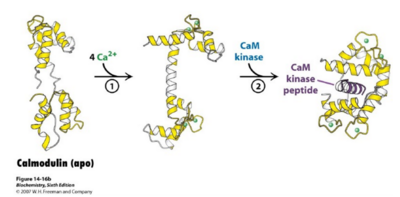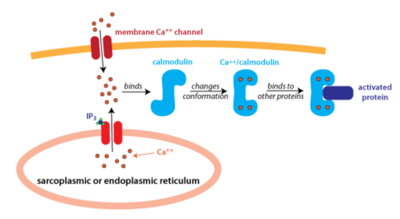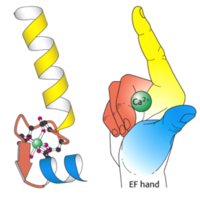Sandbox 4465
From Proteopedia
(Difference between revisions)
| Line 16: | Line 16: | ||
== Structural Highlights == | == Structural Highlights == | ||
| - | Calmodulin has a molecular mass of 16 kilodaltons (kD) and it functions along with ryanodine receptor (RyR)<ref>doi: 10.1242/jcs.133454</ref>. CaM consists of 148 amino acid residues and is characterized by a helix-loop-helix binding motif, also known as the <scene name='71/716518/Efhand/2'>EF hand</scene><ref>doi:10.1016/S0006-3495(98)77876-2</ref>. Calmodulin has one subunit with a distinct dumbbell shape in which a linker region joins two globular domains<ref>doi:10.1371/journal.pcbi.1004063</ref>. Calmodulin is known to undergo a conformational change upon binding with a calcium ion in which each lobe transitions from a closed conformation to an open conformation<ref>doi:10.1002/elps.1150110104</ref>. This protein has four major, high-affinity binding sites, as shown by figure 1. The calmodulin binding region has been shown to be a series of hydrophobic amino acids (such as Trp or Leu), hydrophilic amino acids (such as Glu or Asp), and basic amino acids (such as Arg or Lys)<ref>PMID:1737757</ref>. Calmodulin typically wraps around its target, with the two globular domains gripping either side of it (Figure 1). NMR studies clearly show that the connector between the two calcium binding globular domains is flexible even when it is not bound to its target proteins. However, the full range of flexibility can be seen in calmodulin interactions with its target proteins (Figure 1). | + | Calmodulin has a molecular mass of 16 kilodaltons (kD) and it functions along with ryanodine receptor (RyR)<ref>doi: 10.1242/jcs.133454</ref>. CaM consists of 148 amino acid residues and is characterized by a helix-loop-helix binding motif, also known as the <scene name='71/716518/Efhand/2'>EF hand</scene><ref>doi:10.1016/S0006-3495(98)77876-2</ref>. Calmodulin has one subunit with a distinct dumbbell shape in which a linker region joins two globular domains<ref>doi:10.1371/journal.pcbi.1004063</ref>. Calmodulin is known to undergo a conformational change upon binding with a calcium ion in which each lobe transitions from a closed conformation to an open conformation<ref>doi:10.1002/elps.1150110104</ref>. This protein has four major, high-affinity binding sites, as shown by figure 1. The calmodulin <scene name='71/716518/Bindingsite/1'>binding region</scene> has been shown to be a series of hydrophobic amino acids (such as Trp or Leu), hydrophilic amino acids (such as Glu or Asp), and basic amino acids (such as Arg or Lys)<ref>PMID:1737757</ref>. Calmodulin typically wraps around its target, with the two globular domains gripping either side of it (Figure 1). NMR studies clearly show that the connector between the two calcium binding globular domains is flexible even when it is not bound to its target proteins. However, the full range of flexibility can be seen in calmodulin interactions with its target proteins (Figure 1). |
[[Image:Calmodulin_fig_3.png| thumb|200px| '''Figure 3: An illustration of the EF hand''' The yellow helix represents the ‘E’ portion and the blue helix represents the ‘F’ portion. The cavity inside the hand is where Ca2+ ions bind which induces the conformational changes in the loop region<ref>http://www.ncbi.nlm.nih.gov/books/NBK98188/figure/grisar.f2/</ref>]] | [[Image:Calmodulin_fig_3.png| thumb|200px| '''Figure 3: An illustration of the EF hand''' The yellow helix represents the ‘E’ portion and the blue helix represents the ‘F’ portion. The cavity inside the hand is where Ca2+ ions bind which induces the conformational changes in the loop region<ref>http://www.ncbi.nlm.nih.gov/books/NBK98188/figure/grisar.f2/</ref>]] | ||
Revision as of 01:29, 8 December 2015
Calmodulin
| |||||||||||
Bibliography
- ↑ Eldik, L., & Watterson, D. (1998). Calmodulin and signal transduction
- ↑ Wolfe, D. M. D. M. (2006). Channeling studies in yeast: Yeast as a model for channelopathies?
- ↑

- ↑ MacNeil S., Dawson RA., Crocker G., Barton CH., Hanford L., McGurk MR., and Munro DS., (1988). Extracellular calmodulin and its association with epidermal growth factor in normal human body fluids.
- ↑ Berridge MJ, Lipp P, Bootman MD. The versatility and universality of calcium signalling. Nat Rev Mol Cell Biol. 2000 Oct;1(1):11-21. PMID:11413485 doi:http://dx.doi.org/10.1038/35036035
- ↑ "Cellular Communication: Introduction."Web. <http://courses.washington.edu/conj/bess/communication-overview/reg-overview.html>.
- ↑ Huang X, Liu Y, Wang R, Zhong X, Liu Y, Koop A, Chen SR, Wagenknecht T, Liu Z. Two potential calmodulin-binding sequences in the ryanodine receptor contribute to a mobile, intra-subunit calmodulin-binding domain. J Cell Sci. 2013 Oct 1;126(Pt 19):4527-35. doi: 10.1242/jcs.133454. Epub 2013 Jul, 18. PMID:23868982 doi:http://dx.doi.org/10.1242/jcs.133454
- ↑ Wriggers W, Mehler E, Pitici F, Weinstein H, Schulten K. Structure and dynamics of calmodulin in solution. Biophys J. 1998 Apr;74(4):1622-39. doi: 10.1016/S0006-3495(98)77876-2. PMID:9545028 doi:http://dx.doi.org/10.1016/S0006-3495(98)77876-2
- ↑ Lai M, Brun D, Edelstein SJ, Le Novere N. Modulation of calmodulin lobes by different targets: an allosteric model with hemiconcerted conformational transitions. PLoS Comput Biol. 2015 Jan 22;11(1):e1004063. doi: 10.1371/journal.pcbi.1004063. , eCollection 2015 Jan. PMID:25611683 doi:http://dx.doi.org/10.1371/journal.pcbi.1004063
- ↑ Chan KF, Chen WH. High performance capillary electrophoresis of calmodulin. Electrophoresis. 1990 Jan;11(1):15-8. PMID:2108018 doi:http://dx.doi.org/10.1002/elps.1150110104
- ↑ Bagchi IC, Huang QH, Means AR. Identification of amino acids essential for calmodulin binding and activation of smooth muscle myosin light chain kinase. J Biol Chem. 1992 Feb 15;267(5):3024-9. PMID:1737757
- ↑ http://www.ncbi.nlm.nih.gov/books/NBK98188/figure/grisar.f2/
- ↑ Joseph JD, Means AR. Calcium binding is required for calmodulin function in Aspergillus nidulans. Eukaryot Cell. 2002 Feb;1(1):119-25. doi: 10.1128/ec.01.1.119-125.2002. PMID:12455978 doi:http://dx.doi.org/10.1128/ec.01.1.119-125.2002
- ↑ Lewit-Bentley, A., & Rèty S. (2000). EF-hand calcium-binding proteins. The Journal of current opinion in structural biology, 10(6), 637-643.doi:10.1016/S0959-440X(00)00142-1
- ↑ Racioppi L, Noeldner PK, Lin F, Arvai S, Means AR. Calcium/calmodulin-dependent protein kinase kinase 2 regulates macrophage-mediated inflammatory responses. J Biol Chem. 2012 Mar 30;287(14):11579-91. doi: 10.1074/jbc.M111.336032. Epub, 2012 Feb 14. PMID:22334678 doi:http://dx.doi.org/10.1074/jbc.M111.336032
- ↑ Ui-Tei, K., Nagano, M., Sato, S., & Miyata, Y. (2000). Calmodulin-dependent and -independent apoptosis in cell of a drosophila neuronal cell line



